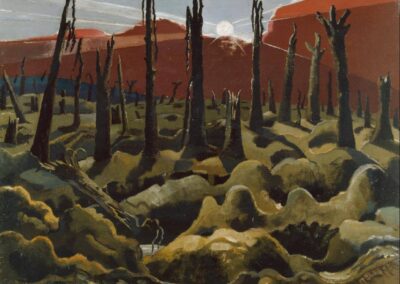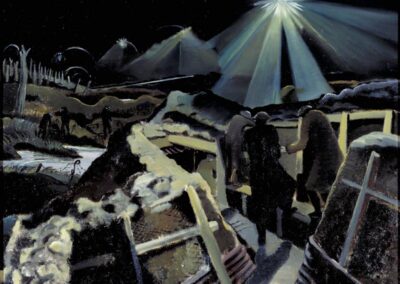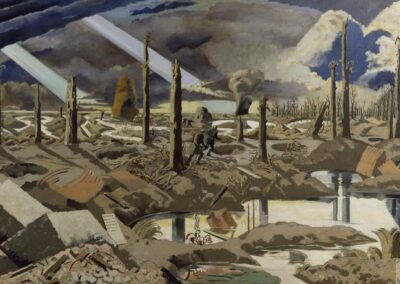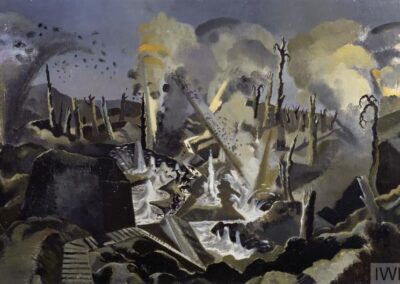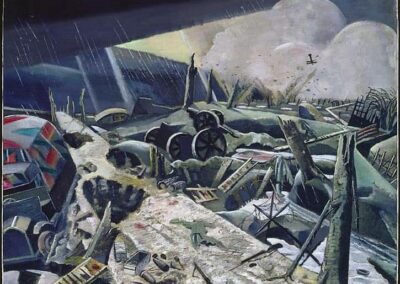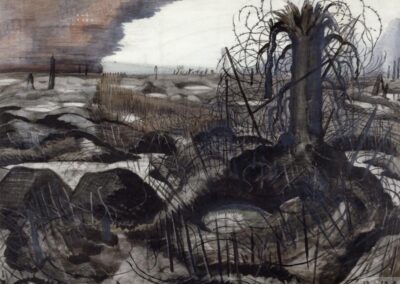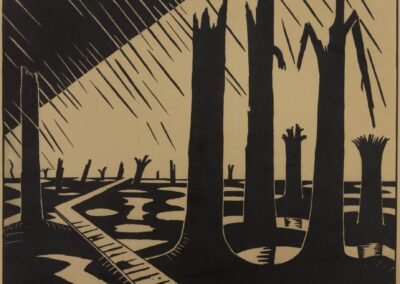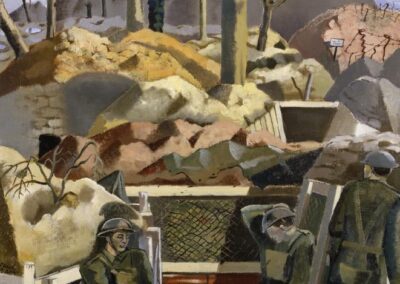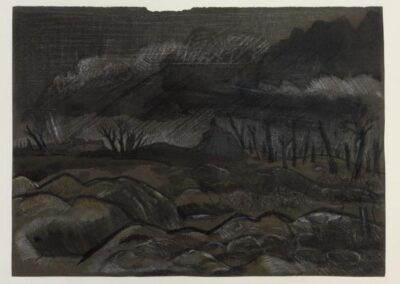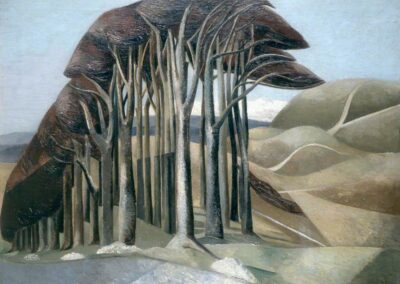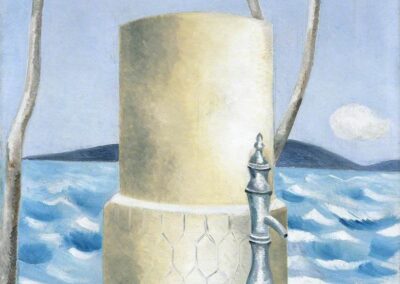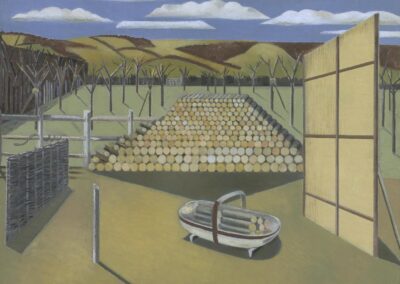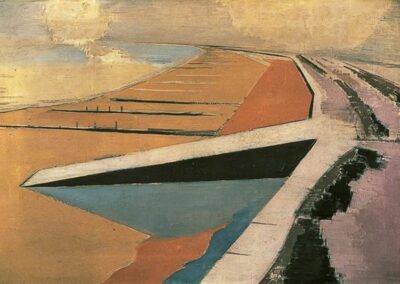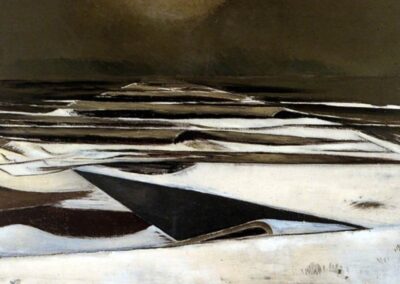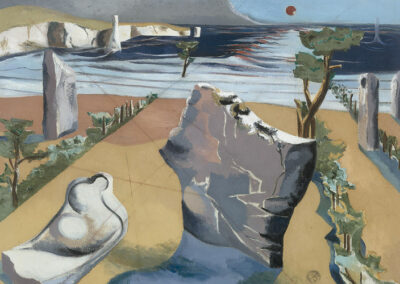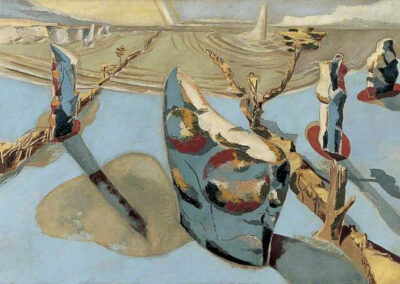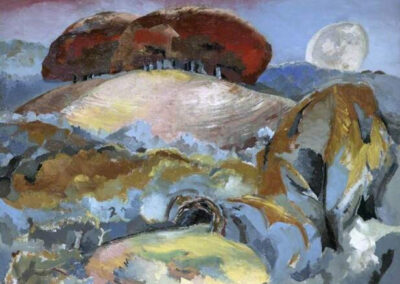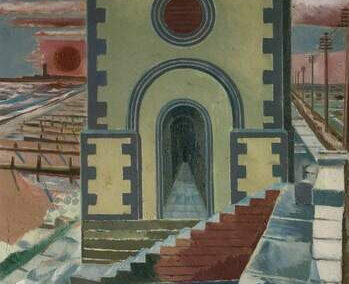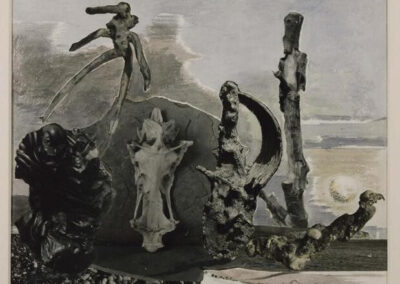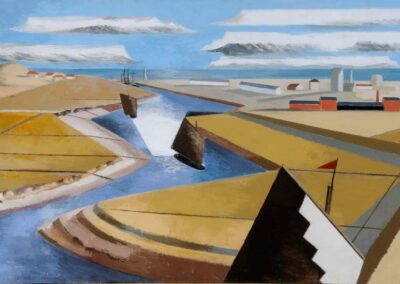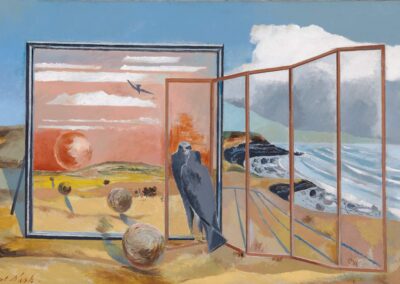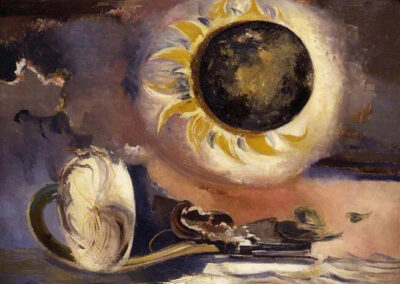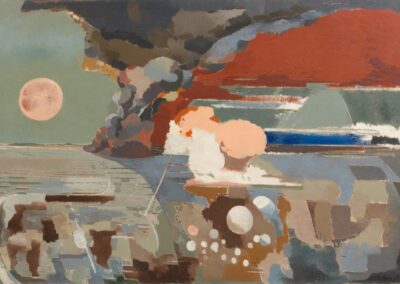The next Artist You Need To Know is Paul Nash (1889 – 1946).
Nash was a British artist best known for his surrealist paintings and his unsettling works as a War Artist : he was also a photographer, writer and designer. He is considered among the most significant British artists of the first half of the 20th century, and was a proponent of Modernism in English art, both through his own artworks and his critical writings.
From here : “Paul Nash painted deeply romantic and lyrical landscapes subtly re-envisioned through the shards of modernism and the horrors of war. He was a prolific and hugely talented artist, a writer, a photographer, a fine book illustrator and designer of stage scenery, fabrics, and posters, as well as most famously, a painter. Although Nash embraced and encompassed many of the major twentieth century art movements, including Surrealism and abstraction, his intense love for nature and surrounding landscape always remained the primary subject of his work. Indeed, even in his duties as official war artist – during both great wars – while documenting the broken debris of battlefields and feeling traumatized by the destruction that he saw, he still managed to make everything that he depicted appear somehow enchanted; gnarled and broken trees resemble ancient standing stones and sunlight or moonbeams usually peak through. As such Nash gives his viewers a magical gift: the insight that even from death springs rebirth, and furthermore, that the imagination always transforms, even the most horrific of scenes.”
“My love of the monstrous and magical led me beyond the confines of natural appearances into unreal worlds.”
Nash was born in London, UK, but his formative years were spent in Buckinghamshire : his father was a lawyer and his mother the daughter of a naval officer (a career that Nash considered but didn’t realize). His family’s relocation to Ivor Heath in Buckinghamshire was primarily an attempt to help his mother with her mental health issues and this strained the family’s resources. Nash’s mother Caroline died in 1910 in an asylum (one might venture that his first hand experience of his mother’s illness was just as formative to Nash’s future aesthetic as the landscape around him, with the standing stones, burial mounds and other aspects of history as manifest in the land).
He attended both the London County Council School of Photo-engraving and Lithography and later the Slade School of Art : but in 1914 with the outbreak of WW I, Nash enlisted for home service (with the intent to remain in England and continue to paint) but – in light of the ongoing slaughter that was the first World War – he was eventually sent to St. Eloi and Ypres. Although injured and sent to a hospital to recover, this inspired some of Nash’s first images of the war, and led to his appointment as an official War Artist, which Nash learned as he was being redeployed to the Ypres Salient, and Nash would experience the Third Battle of Ypres in 1917. This experience would also be a seminal moment in his development as an artist and lead to some of his most impressive and still beautifully horrifying works (one might argue that Nash’s work as a War Artist set a standard for others, as though he was employed in the War Propaganda Bureau, his paintings offered much more than that).
Nash’s paintings of the ‘Great War’ are considered some of the most iconic – both for their formal acumen but also for the honesty in depicting the desolation, absurdity and nihilism of the conflict – paintings of war, and are familiar to many still even more than a century later. A number of these are in the gallery above.
He was also a printmaker, publishing two collections of his wood engravings titled Places and Genesis, in the 1920s. Nash also illustrated books by such renowned authors as Robert Graves and Siegfried Sassoon (both among the top tier of WW I poets, so there was an affinity at play in these collaborations).
Nash also began publishing art criticism with The Listener in 1930 and through this space he became a proponent of modernism in Britain, as well as the more avant-garde movements of abstraction and surrealism that were coming to prominence in continental Europe. He was among the founders of the brief but influential group Unit One in 1933 (alongside Henry Moore, Barbara Hepworth, Ben Nicholson, previously featured Artist You Need To Know Edward Burra and the critic Herbert Read) which was a major factor in the resurgence of visual arts in Britain during the period between the World Wars.
Post WW I, Nash returned to a focus on landscape painting : in the 1930s, he began to incorporate a more abstracted and surreal style. This was often informed by his ongoing interest in the standing stones and other prehistoric ‘architecture’ of Britain, but he would also often inject everyday objects into these scenes. Many of these paintings also employed a mystical symbolism in their imagery and titles.
During this same period, Nash became became friends with previously featured Artist You Need To Know Dora Carrington, as well as having a relationship with the artist Eileen Agar : they also collaborated on a number of artworks.
With the advent of the Second World War, Nash – though afflicted with the asthmatic illness that would eventually be a factor in his death – continued to work, and produced a number of images that picked up the theme of his earlier ‘war works’.
Nash’s artworks can be found in numerous collections, including the Aberdeen Art Gallery, Art Gallery of New South Wales, Beaverbrook Art Gallery, Bolton Art Gallery, Brighton & Hove Museums, Cleveland Museum of Art, Courtauld Institute of Art, Glynn Vivian Art Gallery, Harvard University Art Museums, Imperial War Museum, Manchester City Art Gallery, National Gallery of Victoria, National Museums Liverpool, Tate Gallery, The Huntington Library, The Priseman Seabrook Collection, Royal Air Force Museum London, Whitworth Art Gallery, The Norfolk Museums Collection and Wichita Art Museum.
In 2016 English artist Dave McKean published Black Dog: The Dreams of Paul Nash, a graphic novel about Nash’s life and work : this was a commissioned project by the 14-18Now Foundation, The Imperial War Museum and The Lakes Festival marking a number of centenary commemorations of the First World War.
Paul Nash succumbed to heart failure, in his sleep, which was directly attributed to his long term asthma, in July of 1946, in Boscombe (now Dorset) in Hampshire, UK. He is buried in the churchyard of St Mary the Virgin, Langley in Buckinghamshire (now Berkshire): an Egyptian stone carving of a hawk, that Nash included in one of his best known later paintings Landscape from a Dream (in the gallery above), rests on his grave. His passing – and importance to British art as both an artist and advocate – was marked by a memorial exhibition at the Tate in 1948, that was attended by Queen Elizabeth.
Much more about his life, art and legacy can be enjoyed here and here.

